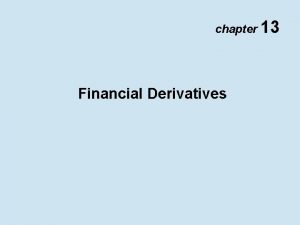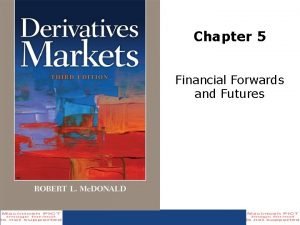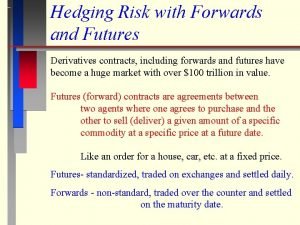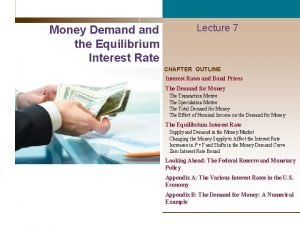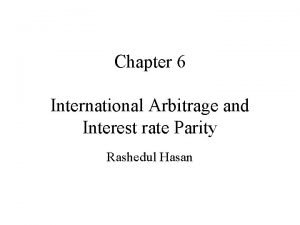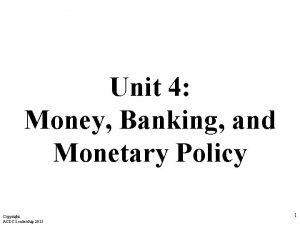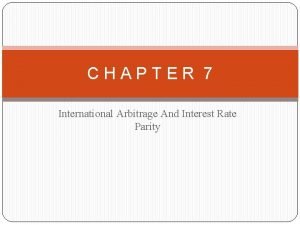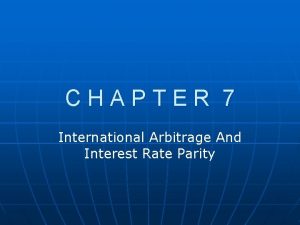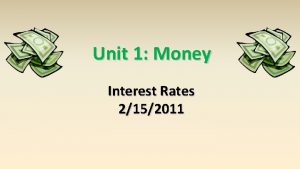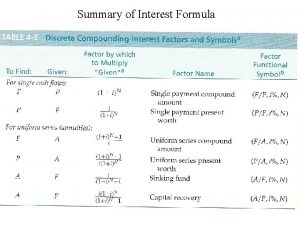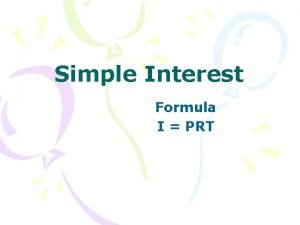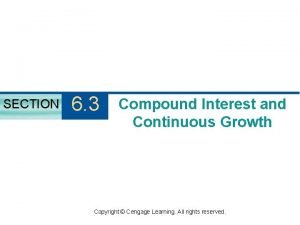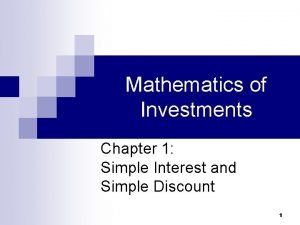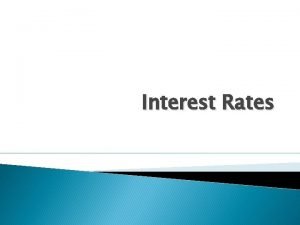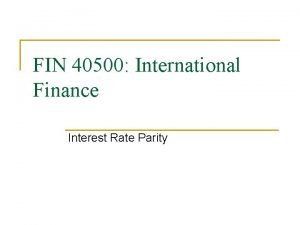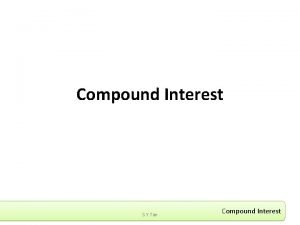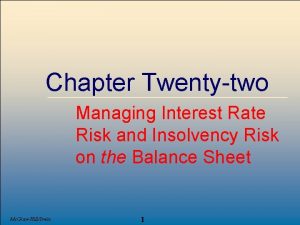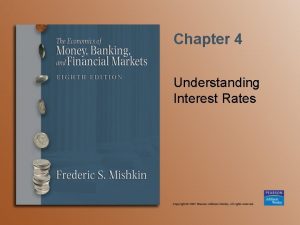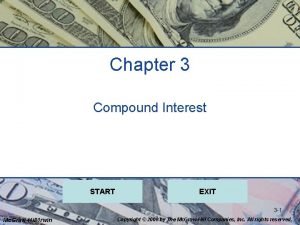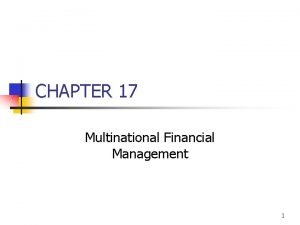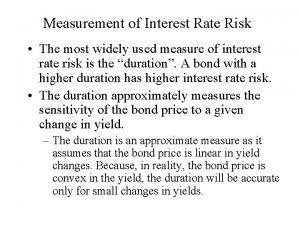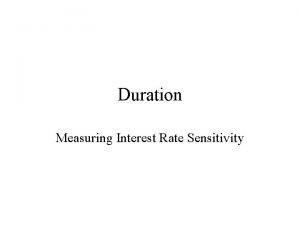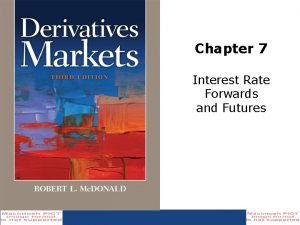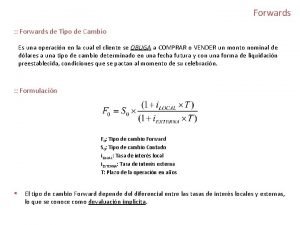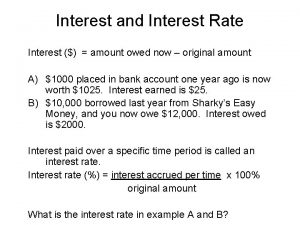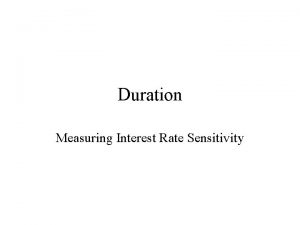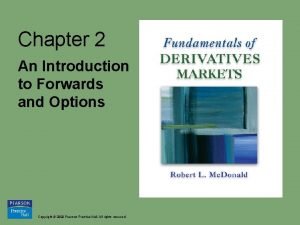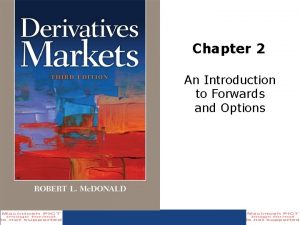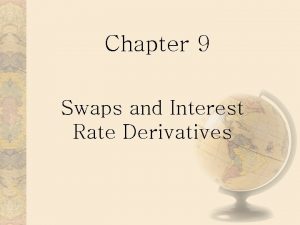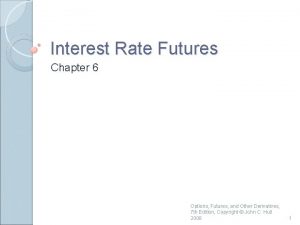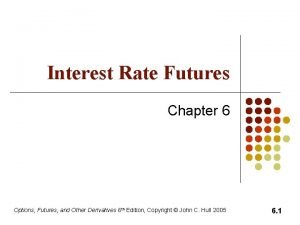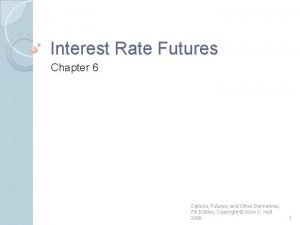Chapter 13 Interest Rate Forwards and Options If
















































- Slides: 48

Chapter 13: Interest Rate Forwards and Options If a deal was mathematically complex in 1993 and 1994, that was considered innovation. But this year, what took you forward with clients wasn’t the math – it was bringing them the most efficient application of a product. Mark Wells Risk, January, 1996, p. R 15 D. M. Chance An Introduction to Derivatives and Risk Management, 6 th ed. Ch. 13: 1

Important Concepts in Chapter 13 n n The notion of a derivative on an interest rate Pricing, valuation, and use of forward rate agreements (FRAs), interest rate options, swaptions, and forward swaps D. M. Chance An Introduction to Derivatives and Risk Management, 6 th ed. 2

n n A derivative on an interest rate: u The payoff of a derivative on a bond is based on the price of the bond relative to a fixed price. u The payoff of a derivative on an interest rate is based on the interest rate relative to a fixed interest rate. u In some cases these can be shown to be the same, particularly in the case of a discount instrument. In most other cases, however, a derivative on an interest rate is a different instrument than a different on a bond. See Figure 13. 1, p. 467 for notional principal of FRAs and interest rate options over time. D. M. Chance An Introduction to Derivatives and Risk Management, 6 th ed. 3

Forward Rate Agreements u Definition FA forward contract in which the underlying is an interest rate u An FRA can work better than a forward or futures on a bond, because its payoff is tied directly to the source of risk, the interest rate. D. M. Chance An Introduction to Derivatives and Risk Management, 6 th ed. 4

Forward Rate Agreements (continued) u The Structure and Use of a Typical FRA F Underlying is usually LIBOR F Payoff is made at expiration (contrast with swaps) and discounted. For FRA on m-day LIBOR, the payoff is F Example: Long an FRA on 90 -day LIBOR expiring in 30 days. Notional principal of $20 million. Agreed upon rate is 10 percent. Payoff will be D. M. Chance An Introduction to Derivatives and Risk Management, 6 th ed. 5

Forward Rate Agreements (continued) F Some possible payoffs. If LIBOR at expiration is 8 percent, F So the long has to pay $98, 039. If LIBOR at expiration is 12 percent, the payoff is the terminology of FRAs: A B means FRA expires in A months and underlying matures in B months. F Note D. M. Chance An Introduction to Derivatives and Risk Management, 6 th ed. 6

Forward Rate Agreements (continued) u The Pricing and Valuation of FRAs F Let F be the rate the parties agree on, h be the expiration day, and the underlying be an m-day rate. L 0(h) is spot rate on day 0 for h days, L 0(h+m) is spot rate on day 0 for h + m days. Assume notional principal of $1. F To find the fixed rate, we must replicate an FRA: • Short a Eurodollar maturing in h+m days that pays 1 + F(m/360). This is a loan that can be paid off early or transferred to another party • Long a Eurodollar maturing in h days that pays $1 D. M. Chance An Introduction to Derivatives and Risk Management, 6 th ed. 7

Forward Rate Agreements (continued) u The Pricing and Valuation of FRAs (continued) F On day h, • Loan we owe has a market value of • Pay if off early. Collect $1 on the ED we hold. So total cash flow is D. M. Chance An Introduction to Derivatives and Risk Management, 6 th ed. 8

Forward Rate Agreements (continued) u The Pricing and Valuation of FRAs (continued) • This can be rearranged to get F This is the payoff of an FRA so this strategy is equivalent to an FRA. With no initial cash flow, we set this to zero and solve for F: F This is just the forward rate in the LIBOR term structure. See Table 13. 1, p. 471 for an example. D. M. Chance An Introduction to Derivatives and Risk Management, 6 th ed. 9

Forward Rate Agreements (continued) u The Pricing and Valuation of FRAs (continued) F Now we determine the market value of the FRA during its life, day g. If we value the two replicating transactions, we get the value of the FRA. The ED we hold pays $1 in h – g days. For the ED loan we took out, we will pay 1 + F(m/360) in h + m – g days. Thus, the value is F See D. M. Chance Table 13. 2, p. 472 for example. An Introduction to Derivatives and Risk Management, 6 th ed. 10

Forward Rate Agreements (continued) u Applications of FRAs F FRA users are typically borrowers or lenders with a single future date on which they are exposed to interest rate risk. F See Table 13. 3, p. 473 and Figure 13. 2, p. 474 for an example. F Note that a series of FRAs is similar to a swap; however, in a swap all payments are at the same rate. Each FRA in a series would be priced at different rates (unless the term structure is flat). You could, however, set the fixed rate at a different rate (called an off-market FRA). Then a swap would be a series of off-market FRAs. D. M. Chance An Introduction to Derivatives and Risk Management, 6 th ed. 11

Interest Rate Options u Definition: an option in which the underlying is an interest rate; it provides the right to make a fixed interest payment and receive a floating interest payment or the right to make a floating interest payment and receive a fixed interest payment. u The fixed rate is called the exercise rate. u Most are European-style. D. M. Chance An Introduction to Derivatives and Risk Management, 6 th ed. 12

Interest Rate Options (continued) u The Structure and Use of a Typical Interest Rate Option F With an exercise rate of X, the payoff of an interest rate call is F The payoff of an interest rate put is F The payoff occurs m days after expiration. F Example: notional principal of $20 million, expiration in 30 days, underlying of 90 -day LIBOR, exercise rate of 10 percent. D. M. Chance An Introduction to Derivatives and Risk Management, 6 th ed. 13

Interest Rate Options (continued) u The Structure and Use of a Typical Interest Rate Option (continued) F If LIBOR is 6 percent at expiration, payoff of a call is F The F If payoff of a put is LIBOR is 14 percent at expiration, payoff of a call is F The D. M. Chance payoff of a put is An Introduction to Derivatives and Risk Management, 6 th ed. 14

Interest Rate Options (continued) u Pricing and Valuation of Interest Rate Options FA difficult task; binomial models are preferred, but the Black model is sometimes used with the forward rate as the underlying. F When the result is obtained from the Black model, you must discount at the forward rate over m days to reflect the deferred payoff. F Then to convert to the premium, multiply by (notional principal)(days/360). F See Table 13. 4, p. 478 for illustration. D. M. Chance An Introduction to Derivatives and Risk Management, 6 th ed. 15

Interest Rate Options (continued) u Interest Rate Option Strategies F See Table 13. 5, p. 479 and Figure 13. 3, p. 480 for an example of the use of an interest rate call by a borrower to hedge an anticipated loan. F See Table 13. 6, p. 481 and Figure 13. 4, p. 483 for an example of the use of an interest rate put by a lender to hedge an anticipated loan. D. M. Chance An Introduction to Derivatives and Risk Management, 6 th ed. 16

Interest Rate Options (continued) u Interest Rate Caps, Floors, and Collars FA combination of interest rate calls used by a borrower to hedge a floating-rate loan is called an interest rate cap. The component calls are referred to as caplets. F A combination of interest rate floors used by a lender to hedge a floating-rate loan is called an interest rate floor. The component puts are referred to as floorlets. F A combination of a long cap and short floor at different exercise prices is called an interest rate collar. D. M. Chance An Introduction to Derivatives and Risk Management, 6 th ed. 17

Interest Rate Options (continued) u Interest Rate Caps, Floors, and Collars (continued) F Interest Rate Cap • Each component caplet pays off independently of the others. • See Table 13. 7, p. 485 for an example of a borrower using an interest rate cap. • To price caps, price each component caplet individually and add up the prices of the caplets. D. M. Chance An Introduction to Derivatives and Risk Management, 6 th ed. 18

Interest Rate Options (continued) u Interest Rate Caps, Floors, and Collars (continued) F Interest Rate Floor • Each component floorlet pays off independently of the others • See Table 13. 8, p. 486 for an example of a lender using an interest rate floor. • To price floors, price each component floorlet individually and add up the prices of the floorlets. D. M. Chance An Introduction to Derivatives and Risk Management, 6 th ed. 19

Interest Rate Options (continued) u Interest Rate Caps, Floors, and Collars (continued) F Interest • • Rate Collars A borrower using a long cap can combine it with a short floor so that the floor premium offsets the cap premium. If the floor premium precisely equals the cap premium, there is no cash cost up front. This is called a zero-cost collar. The exercise rate on the floor is set so that the premium on the floor offsets the premium on the cap. By selling the floor, however, the borrower gives up gains from falling interest rates below the floor exercise rate. See Table 13. 9, p. 487 for example. D. M. Chance An Introduction to Derivatives and Risk Management, 6 th ed. 20

Interest Rate Options (continued) u Interest Rate Options, FRAs, and Swaps F Recall that a swap is like a series of off-market FRAs. F Now compare a swap to interest rate options. On a settlement date, the payoff of a long call is • 0 if LIBOR X • LIBOR – X if LIBOR > X F The payoff of a short put is • - (X – LIBOR) if LIBOR X • 0 if LIBOR > X F These combine to equal LIBOR – X. If X is set at R, which is the swap fixed rate, the long cap and short floor replicate the swap. D. M. Chance An Introduction to Derivatives and Risk Management, 6 th ed. 21

Interest Rate Swaptions and Forward Swaps u Definition of a swaption: an option to enter into a swap at a fixed rate. F Payer swaption: an option to enter into a swap as a fixed -rate payer F Receiver swaption: an option to enter into a swap as a fixed-rate receiver D. M. Chance An Introduction to Derivatives and Risk Management, 6 th ed. 22

Interest Rate Swaptions and Forward Swaps (continued) u The Structure of a Typical Interest Rate Swaption F Example: MPK considers the need to engage in a $10 million three-year swap in two years. Worried about rising rates, it buys a payer swaption at an exercise rate of 11. 5 percent. Swap payments will be annual. • At expiration, the following rates occur (Eurodollar zero coupon bond prices in parentheses): – 360 day rate: . 12 (0. 8929) – 720 day rate: . 1328 (0. 7901) – 1080 day rate: . 1451 (0. 6967) D. M. Chance An Introduction to Derivatives and Risk Management, 6 th ed. 23

Interest Rate Swaptions and Forward Swaps (continued) u The Structure of a Typical Interest Rate Swaption (continued) • The rate on 3 -year swaps is, therefore, • So MPK could enter into a swap at 12. 75 percent in the market or exercise the swaption and enter into a swap at 11. 5 percent. Obviously it would exercise the swaption. What is the swaption worth? D. M. Chance An Introduction to Derivatives and Risk Management, 6 th ed. 24

Interest Rate Swaptions and Forward Swaps (continued) u The Structure of a Typical Interest Rate Swaption (continued) • Exercise would create a stream of 11. 5 percent fixed payments and LIBOR floating receipts. MPK could then enter into the opposite swap in the market to receive 12. 75 fixed and pay LIBOR floating. The LIBORs offset leaving a three-year annuity of 12. 75 – 11. 5 = 1. 25 percent, or $125, 000 on $10 million notional principal. The value of this stream of payments is $125, 000(0. 8929 + 0. 7901 + 0. 6967) = $297, 463 D. M. Chance An Introduction to Derivatives and Risk Management, 6 th ed. 25

Interest Rate Swaptions and Forward Swaps (continued) u The Structure of a Typical Interest Rate Swaption (continued) F In general, the value of a payer swaption at expiration is F The D. M. Chance value of a receiver swaption at expiration is An Introduction to Derivatives and Risk Management, 6 th ed. 26

Interest Rate Swaptions and Forward Swaps (continued) u The Equivalence of Swaptions and Options on Bonds F Using the above example, substituting the formula for the swap rate in the market, R, into the formula for the payoff of a swaption gives • Max(0, 1 – 0. 6967 -. 115(0. 8929 + 0. 7901 + 0. 6967)) F This is the formula for the payoff of a put option on a bond with 11. 5 percent coupon where the option has an exercise price of par. So payer swaptions are equivalent to puts on bonds. Similarly, receiver swaptions are equivalent to calls on bonds. D. M. Chance An Introduction to Derivatives and Risk Management, 6 th ed. 27

Interest Rate Swaptions and Forward Swaps (continued) u Pricing Swaptions F We do not cover this advanced topic here, but note that based on the previous result, we would price swaptions using models for pricing options on bonds. D. M. Chance An Introduction to Derivatives and Risk Management, 6 th ed. 28

Interest Rate Swaptions and Forward Swaps (continued) u Forward Swaps F Definition: a forward contract to enter into a swap; a forward swap commits the parties to entering into a swap at a later date at a rate agreed on today. F Example: The MPK situation previously described. Let MPK commit to a three-year pay-fixed, receive-floating swap in two years. To find the fixed rate at the time the forward swap is agreed to, we need the term structure of rates for one through five years (Eurodollar zero coupon bond prices shown in parentheses). D. M. Chance An Introduction to Derivatives and Risk Management, 6 th ed. 29

Interest Rate Swaptions and Forward Swaps (continued) u Forward Swaps (continued) • 360 days: . 09 (0. 9174) • 720 days: . 1006 (0. 8325) • 1080 days: . 1103 (0. 7514) • 1440 days: . 12 (0. 6757) • 1800 days: . 1295 (0. 6070) F We need the forward rates two years ahead for periods of one, two, and three years. D. M. Chance An Introduction to Derivatives and Risk Management, 6 th ed. 30

Interest Rate Swaptions and Forward Swaps (continued) u Forward Swaps (continued) D. M. Chance An Introduction to Derivatives and Risk Management, 6 th ed. 31

Interest Rate Swaptions and Forward Swaps (continued) u Forward Swaps (continued) F The D. M. Chance Eurodollar zero coupon (forward) bond prices An Introduction to Derivatives and Risk Management, 6 th ed. 32

Interest Rate Swaptions and Forward Swaps (continued) u Forward Swaps (continued) F The D. M. Chance rate on the forward swap would be An Introduction to Derivatives and Risk Management, 6 th ed. 33

Interest Rate Swaptions and Forward Swaps (continued) u Applications of Swaptions and Forward Swaps F Anticipation of the need for a swap in the future F Swaption can be used • To exit a swap • As a substitute for an option on a bond • Creating synthetic callable or puttable debt F Remember that forward swaps commit the parties to a swap but require no cash payment up front. Options give one party the choice of entering into a swap but require payment of a premium up front. D. M. Chance An Introduction to Derivatives and Risk Management, 6 th ed. 34

Summary D. M. Chance An Introduction to Derivatives and Risk Management, 6 th ed. 35

(Return to text slide) D. M. Chance An Introduction to Derivatives and Risk Management, 6 th ed. 36

(Return to text slide) D. M. Chance An Introduction to Derivatives and Risk Management, 6 th ed. 37

(Return to text slide) D. M. Chance An Introduction to Derivatives and Risk Management, 6 th ed. 38

(Return to text slide) D. M. Chance An Introduction to Derivatives and Risk Management, 6 th ed. 39

(Return to text slide) D. M. Chance An Introduction to Derivatives and Risk Management, 6 th ed. 40

(Return to text slide) D. M. Chance An Introduction to Derivatives and Risk Management, 6 th ed. 41

(Return to text slide) D. M. Chance An Introduction to Derivatives and Risk Management, 6 th ed. 42

(Return to text slide) D. M. Chance An Introduction to Derivatives and Risk Management, 6 th ed. 43

(Return to text slide) D. M. Chance An Introduction to Derivatives and Risk Management, 6 th ed. 44

(Return to text slide) D. M. Chance An Introduction to Derivatives and Risk Management, 6 th ed. 45

(Return to text slide) D. M. Chance An Introduction to Derivatives and Risk Management, 6 th ed. 46

(Return to text slide) D. M. Chance An Introduction to Derivatives and Risk Management, 6 th ed. 47

(Return to text slide) D. M. Chance An Introduction to Derivatives and Risk Management, 6 th ed. 48
 What is real interest rate and nominal interest rate
What is real interest rate and nominal interest rate Forwards vs futures vs options vs swaps
Forwards vs futures vs options vs swaps Cap rate interest rate relationship
Cap rate interest rate relationship Prepaid forward contract formula
Prepaid forward contract formula Fx forwards manchester
Fx forwards manchester Fed tapering
Fed tapering Forward valuation
Forward valuation Mercados de forwards y swaps
Mercados de forwards y swaps When i was one i had just begun the day i went to sea
When i was one i had just begun the day i went to sea Simple and compound interest
Simple and compound interest Effective interest vs nominal interest
Effective interest vs nominal interest Money demand and interest rate
Money demand and interest rate International arbitrage example
International arbitrage example Decreasing money supply
Decreasing money supply Intersecurity arbitrages
Intersecurity arbitrages Locational arbitrage
Locational arbitrage Interest rate effect
Interest rate effect What is discrete compounding
What is discrete compounding Prt = i
Prt = i Amount formula in si
Amount formula in si Compounded continuously formula
Compounded continuously formula Nominal versus real returns
Nominal versus real returns Dad-das model
Dad-das model Effective rate of interest
Effective rate of interest Interest rate transmission mechanism
Interest rate transmission mechanism Unit 5 lesson 2 fiscal and monetary policy
Unit 5 lesson 2 fiscal and monetary policy Find the principal
Find the principal Interest rate parity theorem
Interest rate parity theorem Interest rate quotes
Interest rate quotes Cheapest to deliver futures
Cheapest to deliver futures Interest rate parity
Interest rate parity Uncovered interest rate parity formula
Uncovered interest rate parity formula Justin borrowed 5 000 at 5 annual simple interest rate
Justin borrowed 5 000 at 5 annual simple interest rate Interest rate parity example
Interest rate parity example Interest rate duration
Interest rate duration Interest rate futures
Interest rate futures Mora interest rate
Mora interest rate Interest rate compounded annually
Interest rate compounded annually Types of leases
Types of leases Interest rate parity example
Interest rate parity example What is expansionary monetary policy
What is expansionary monetary policy Effective monthly interest rate
Effective monthly interest rate Rumus bunga
Rumus bunga Agdao cooperative
Agdao cooperative Measure interest rate risk
Measure interest rate risk Interest rate parity
Interest rate parity Interest rate risk sensitivity analysis
Interest rate risk sensitivity analysis Forward interest rate formula
Forward interest rate formula Forward interest rate formula
Forward interest rate formula

